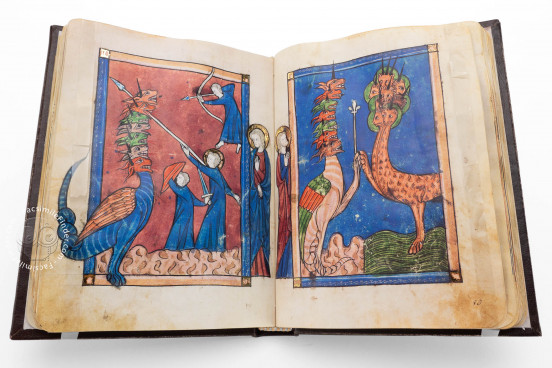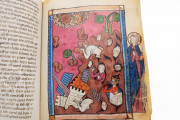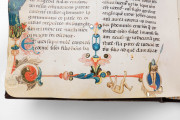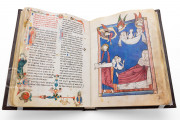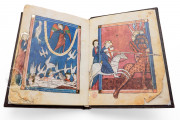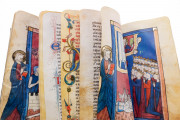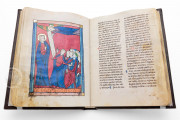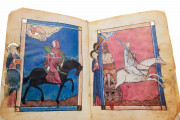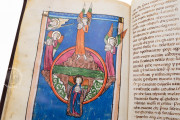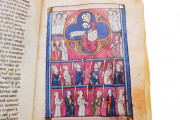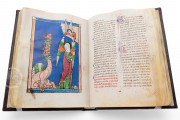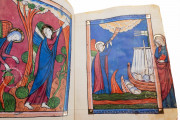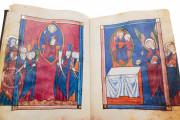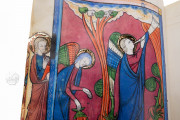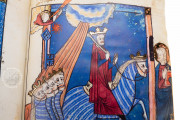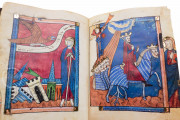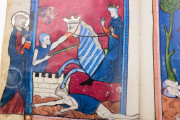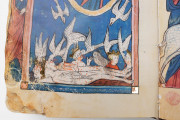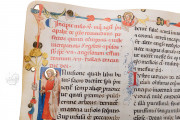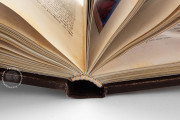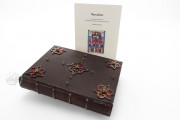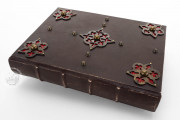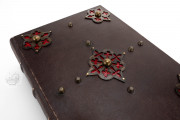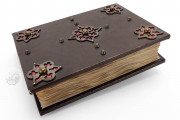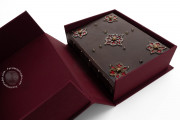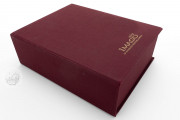The Ashburnham Apocalypse, a manuscript of the Christian biblical book of the Apocalypse with commentary, is a fascinating marriage of English, French, and Italian apocalyptic traditions at the height of Gothic Apocalypse production in Europe. Although the manuscript—made in France and Italy in the late thirteenth century and around 1331-1334—is incomplete, what survives speaks to the influence in the Italian commentary by millenarian theologian Joachim of Fiore. The fifty-two miniatures, however, were probably created by a French artist and are influenced by the English picture book Apocalypses of the mid-thirteenth century.
The miniatures, all full-page and painted in Metz, were not created for the manuscript's current text, written in Italy and often employing blank parchment on the backs of the miniatures. That text, with the biblical passages in Latin and the commentary in Italian, is uniquely preserved in this manuscript.
Bold Colors
The artist of the miniatures in the Ashburnham Apocalypse worked in a mature French Gothic style characterized by large figures isolated against deep blue and fuchsia backgrounds. The drapery is rendered in broad, apparently heavy folds, and the images have an unfussy clarity. The figure of Saint John the Divine is often pictured outside the frame, experiencing his vision of the end of time.
Unusual Format
The miniatures of most illuminated Apocalypse manuscripts of the period, including the closely related Apocalypse of Lorraine, are in landscape format (wider than tall). The miniatures of the Ashburnham Apocalypse are remarkable for their full-page format, all in portrait format (taller than wide). The resultant spaciousness of the Ashburnham book's paintings often reveals a reliance on models in landscape format.
Picturing the Apocalypse
The Ashburnham Apocalypse's miniatures strictly illustrate the biblical text, not the commentary. Included are three of the famous four horsemen of the Apocalypse, each accorded his own miniature (fols. 1r, 2v, and 3r). Also pictured are the blowing of the trumpets (fols. 29v, 30r, 33v, 34r, 36r, and 46v) and the distribution and pouring out of the vessels (fols. 104r, 107r, 110v, and 114v).
Decorating the Text
The text pages with painted initials and border extensions are in a different style, one entirely Italian and characteristic of Bolognese illumination. Among the many painted initials are some historiated (e.g., on fols. 87v, 89r, 118v, and 135v) and some zoomorphic (e.g., on fols. 63v and 68v). The fleshy leaves and golden balls of the extensions are often found in contemporary manuscripts from Bologna.
Text in Two Columns
The manuscript has losses at the beginning and the end. The main text, written by a single scribe in Gothic Rotunda, is in two columns. Besides the full text of the Apocalypse and its commentary (Apocalypse 6-20 surviving), there is a paraphrase of the Apocalypse and interlinear glosses written by subsequent scribes.
Named for Former Owners
The manuscript owes its nickname to its possession in the collection of earls of Ashburnham: Bertram Ashburnham (1797-1878), Earl of Ashburnham, and then Bertram Ashburnham, Earl of Ashburnham (1840-1913). It was previously owned by Giuseppe Orazio Pucci (1782-1838). The Ashburnham collection of manuscripts was purchased by the Italian government in 1884 and eventually assigned to the Laurentian Library. The current binding, dating from the eighteenth or nineteenth century, is of blind-tooled leather over pasteboard.
We have 1 facsimile edition of the manuscript "Ashburnham Apocalypse": Apocalisse Ashburnham facsimile edition, published by Imago, 2021
Request Info / Price
